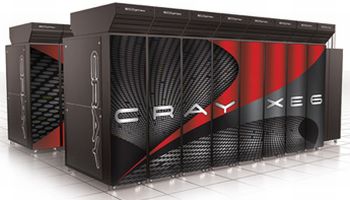Supercomputer maker Cray will bring together CPUs from Advanced Micro Devices (AMD) and graphics technology from Nvidia to upgrade the massive Jaguar system at a national laboratory and create what could become the world’s more powerful supercomputer.
Cray officials in May unveiled its latest hybrid CPU-GPU supercomputer, the XK6, which will be powered by AMD’s upcoming 16-core Opteron 6200 “Interlagos” chips and Nvidia’s Tesla20 Series graphics processing units (GPUs), and will include Cray’s own Gemini interconnect technology.
Jaguar Morphs Into Titan
Cray has announced that it will upgrade the Jaguar supercomputer at the Oak Ridge National Laboratory inTennessee, turning Jaguar into what will be known as Titan, a system with a peak performance of 10 to 20 petaflops – a petaflop equals a quadrillion floating point calculations per second – of power, according to Cray.
 By comparison, the world’s fastest supercomputer, Japan’s K system, has a peak performance of almost 8.8 petaflops. Jaguar had been the world’s fastest until last year. Cray officials described the XK6 as a tightly integrated supercomputer that will includes the CPUs, GPUs, Gemini interconnect and high-performance software. The result will be a system that enables researchers at theOak Ridge lab to throw massive amounts of computer power at the most complex problems dealing with energy and environmental issues.
By comparison, the world’s fastest supercomputer, Japan’s K system, has a peak performance of almost 8.8 petaflops. Jaguar had been the world’s fastest until last year. Cray officials described the XK6 as a tightly integrated supercomputer that will includes the CPUs, GPUs, Gemini interconnect and high-performance software. The result will be a system that enables researchers at theOak Ridge lab to throw massive amounts of computer power at the most complex problems dealing with energy and environmental issues.
“The new system will enable even further amazing scientific achievements,” Cray President and CEO Peter Ungaro said in a statement.
 Ungaro added that Titan will be a key step in the company’s stated goal of scaling the peak performance of the XK6 (pictured right) to more than 50 petaflops.
Ungaro added that Titan will be a key step in the company’s stated goal of scaling the peak performance of the XK6 (pictured right) to more than 50 petaflops.
High-performance computing organisations increasingly have been turning to hybrid CPU-GPU supercomputers to leverage the processing and parallel computing capabilities of graphics chips. In addition, chip makers AMD and larger rival Intel also are integrating high-level graphics technologies and CPUs on a single piece of silicon to boost the performance of their processors while driving down power consumption.
Approval For Mustang
Cray’s announcement came a day before the Los Alamos National Laboratory’s Institutional Computing Programme announced it is deploying a supercomputer from Appro – the ApproXtreme-X – for scientific research around such areas as the oceans, plasma physics and nuclear energy. Codenamed “Mustang”, the system powered by AMD’s 12-core Opteron 6100 processors, includes 38,400 processing cores and can reach a performance of 353 teraflops.
Cray’s $97 million project with the Oak Ridge facilities will be done in phases, with the first phase including replacing the current XT5 compute blades with Cray’s XK6 blades, which will comprise the AMD Interlagos chips, the Gemini interconnect and a subset of XK6 nodes powered by Nvidia’s Tesla GPUs. Cray officials said they expect to complete the first phase of the project by the end of the year, despite a delay by AMD in shipping the Interlagos chips.
AMD announced in late September that problems with manufacturing partner Globalfoundries’ fabrication plant in Dresden, Germany, had delayed the shipment of Interlagos chips, which happened later in the third quarter than was expected.
The second phase of Cray’s projects will include equipping the Titan system with Nvidia’s next-generation Tesla “Kepler” GPUs, and should be finished in the second half of 2012. Upgrades beyond the two phases could increase the total value of the contract, according to Cray.




